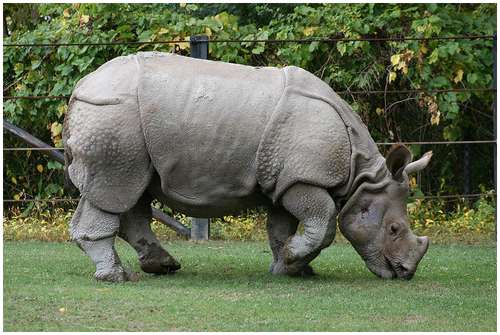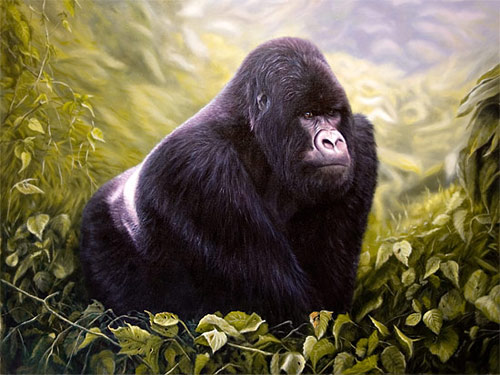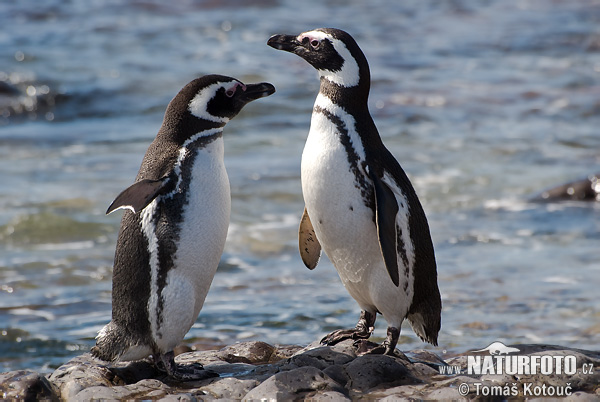With the U.N. Convention on International Trade in Endangered Species Conference being held today in Doha, Qatar, I thought it was a good time to learn more about some of the animals that are probably at or near the top of the list of those that will be discussed.

Javan Rhinoceros: Native to Indonesia, Southeast Asia, India, and China, this was once the most wide-spread of all Asian rhinos. It is now considered the most endangered large mammal in the world. With no natural predators other than humans, their decline is entirely due to poaching for their horns, which is highly valued in traditional Chinese medicine and can bring as much as much as $30,000 per kilogram on the black market. There are now less than 60 left.

Mountain Gorilla: Native to The Congo and Uganda, these animals have received the most attention in regard to their survival, with many organizations, including the United Nations, attempting to save them from extinction. The reasons for their decline include intense poaching along with habitat destruction and the bushmeat trade. As many as 5,000 may have died in recent outbreaks of the Ebola virus in central Africa. There are now about 720 left.
Giant Panda: The rarest member of the bear family, the panda is in danger due to infringement on its natural habitat by roads and railroads as well as continual poaching. Native only to the Yangtze Basin in China, it only eats bamboo, so relocating it and trying to build new populations is not a viable option. China has established 50 panda reserves and is making large efforts to protect the remaining pandas. There are currently less than 2,500 pandas left.
Tiger: Of the original eight sub-species of Tigers, three have already gone extinct. These are the Bali Tiger (in the 30’s), the Caspian Tiger (in the 70’s), and the Javan Tiger in the 80’s. The remaining five are the Bengal, the IndoChinese, the Siberian, the South China and the Sumatran. All five are critically endangered. Huge profits are still being made selling their skins and body parts for use in traditional chinese medicine. There are currently about 3,200 left.

Polar Bear: With the ice that they depend on so much for life literally disappearing under their feet, polar bears have become the poster child for global warming. There are currently only two populations of Polar Bears in the U.S. They are not internationally protected, so Canada, which currently exports skins and products from about 300 polar bears legally shot each year, sees no reason to stop their current practices. The number left is between 20,000 and 25,000.
Leatherback Turtle: The largest marine turtle and one of the largest living reptiles, this species has survived for more than 100 million years – until now. Because of it’s somewhat soft, rubbery shell and flippers, this turtle is so distinctive that it has it's own family, Dermochelys. Fishing nets, beach erosion, pollution and a lack of safe nesting beaches have decimated their numbers. There are about 30,000 left with the Eastern Pacific turtles now facing immediate extinction.

Pacific Walrus: Another victim of global warming, these walruses, native to the Arctic Ocean between Alaska and Siberia, need sea ice in order to survive. On the ice is where they breed, rest, and eat. Calves are in the most danger because they are not strong enough to swim continuously and, without ice to rest on, they drown. Walruses cannot live on land, so when the ice is gone, they will be gone as well.

Magellanic Penguin: These are native to the southern coast of South America including the Falkland Islands and the coasts of Argentina and Chile. Their food has become scarce because of commercial fishing of squid and fish. Their populations have also declined because of pollution from oily ballast water released by tankers. An estimated 40,000 are killed annually by oil pollution in Argentina and are being found washed up on beaches emaciated and dead.

Monarch Butterfly: In one of the most remarkable natural phenomena on the planet, these butterflies migrate by the millions from Canada and the U.S. to Mexico each year, where they over-winter in a high-altitude pine and fir forest. Unfortunately, this forest wasn’t being protected from loggers, who cut down a large portion of the trees. Efforts are being made by the Mexican Fund for the Conservation of Nature to protect the forest and establish new trees.

Bluefin Tuna: These are the source of the highest grade of sushi and sashimi in the world and Japan is by far the biggest consumer. For the last 4 decades, no control has been placed on the number that can be caught, and their population has been decimated as a result. Today, a single healthy-sized adult can easily fetch more than $100,000 in Tokyo's largest fish market. Natives of the Eastern Atlantic and the Mediterranean Sea, researchers warn that the stock is in danger of “imminent collapse”.













0 Comments